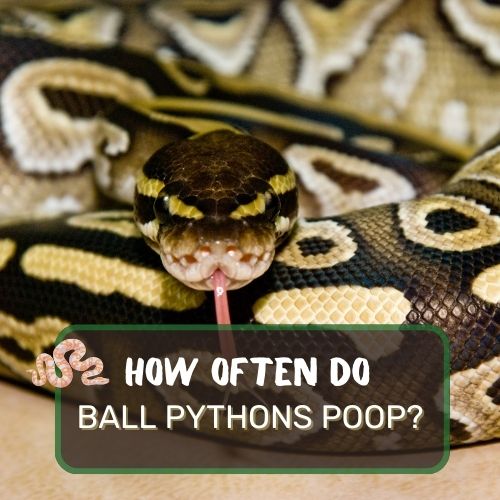
Have you ever found yourself pondering the question, “how often do ball pythons poop?” If so, you’re not alone!
This seemingly simple query opens the door to a fascinating exploration of ball python physiology and care.
In this article, we’ll delve deep into the factors affecting a ball python’s defecation frequency, from its age and diet to environmental conditions.
By understanding these elements, you’ll gain insights into your slithery friend’s overall health and well-being.
So, whether you’re a seasoned snake enthusiast or a curious newbie, read on to discover the intriguing world of ball python digestion and what it reveals about these captivating creatures.
Table of Contents
How Often Do Ball Pythons Poop?
Ball pythons typically poop about once a week after consuming a meal. However, this frequency can vary based on several factors, including the snake’s diet, environment, and overall health. In ideal conditions, after consuming a meal, a ball python completes its digestion process within 6-8 days, defecating shortly thereafter. It’s essential for owners to monitor their python’s defecation patterns, as irregularities can be indicators of health issues.
If a ball python hasn’t defecated two weeks post-feeding, it might need some assistance, and if the delay extends beyond three weeks, a visit to the vet is recommended.

Factors Affecting Poop Frequency
Ah, the age-old question for ball python enthusiasts: “How often do ball pythons poop?” Well, just like us humans, several factors can influence the frequency of a ball python’s bathroom habits. Let’s dive deep and unravel this mystery!
Age and Feeding Routine
Younger ball pythons, being the energetic little slitherers they are, tend to eat more frequently than their older counterparts. As a result, they also poop more often. A juvenile might eat once a week and, like clockwork, poop a week after.
On the other hand, an adult ball python, with its more leisurely feeding schedule of once every two weeks, might take its sweet time before leaving you a “gift”. It’s all about the feeding routine!
Prey Size
Imagine having a light salad versus a full three-course meal. The latter is bound to keep you feeling full longer, right? Similarly, the size of the prey can influence a ball python’s digestive schedule.
A larger prey item, like a big rat, will take longer to digest compared to a smaller mouse. This means the python will take longer before it feels the need to defecate.
Snake Size
Size does matter, at least when it comes to digestion! Larger snakes have longer digestive tracts, which means food takes a more extended tour before making its exit.
So, a bigger ball python might take a tad longer to poop compared to its pint-sized pals.
Hydration
Water plays a crucial role in digestion. Just as we’re always told to drink water to aid digestion, the same goes for our scaly friends. A well-hydrated ball python will have a smoother and more regular defecation routine.
If you notice irregularities, check the water dish. A simple sip can make all the difference!
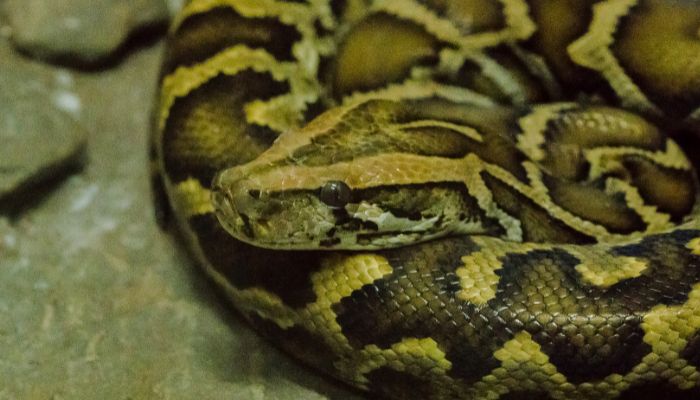
Shedding
Shedding is like a ball python’s spa day. During this time, they’re more focused on getting rid of their old skin than digesting food. You might notice a slight delay in their pooping schedule when they’re in the shedding phase.
But don’t worry, once they’re all shiny and new, they’ll get right back on track.
Temperature
Ball pythons are cold-blooded, which means they rely on external temperatures for their bodily functions, including digestion. If it’s too cold, their metabolic rate drops, slowing down digestion.
On the flip side, a warm and cozy environment can speed things up. So, if you’re wondering why your snake is off its pooping schedule, you might want to check the thermostat.
Parasites
Nobody likes uninvited guests, especially when they’re parasites. These pesky intruders can disrupt a ball python’s digestive system, leading to irregular pooping patterns.
If you suspect your snake has parasites (like if you see mucus in their poop or if they’re losing weight), it’s time for a vet visit.
The general rule of thumb is that ball pythons poop about a week after eating, but several factors can influence this schedule.
By understanding these factors, you can ensure your slithery friend stays healthy and regular. After all, a pooping python is a happy python!
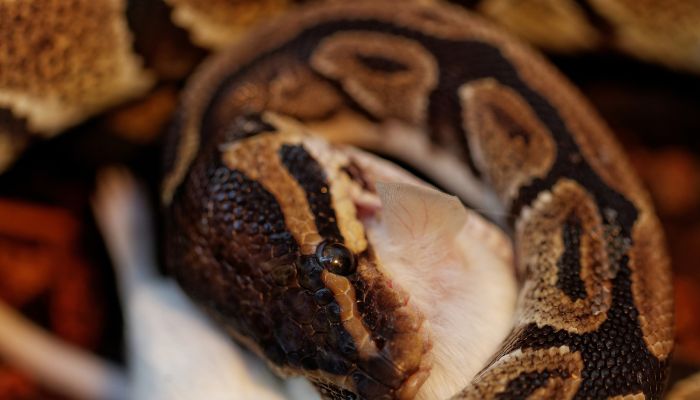
Digestion 101: How Ball Pythons Process Food
Their ability to process food efficiently and extract the maximum nutrients is nothing short of impressive. But how exactly do these slithering creatures manage such a feat? Let’s dive into the world of ball python digestion!
Efficiency of Snake’s Digestive Track
Ball pythons, like other snakes, have a highly specialized digestive tract designed for their unique dietary needs. Unlike us humans, who munch on various foods throughout the day, ball pythons feast on larger prey items less frequently.
Their digestive system is equipped to handle this infrequent but substantial intake. Once the python swallows its prey, powerful digestive enzymes and stomach acids get to work, breaking down the food efficiently.
This process ensures that every possible nutrient is extracted, leaving very little waste.
Percentage of Food Absorbed vs. Excreted
It’s fascinating to note that ball pythons absorb a whopping 91% of the food they consume. Yes, you read that right! Only about 9% of their meal ends up as waste.
This incredible efficiency means that nearly every part of their prey, from the protein-rich muscles to the calcium-filled bones, is used to fuel the snake’s body.
The tiny percentage that’s excreted mainly consists of indigestible parts, like fur or feathers.
This is why, when a ball python poops, you might notice some hair or other remnants in their feces. It’s a testament to their digestive prowess!
Importance of Efficient Digestion for Sit-and-Wait Predators
Now, you might wonder, why do ball pythons need such an efficient digestive system? The answer lies in their hunting strategy. Ball pythons, and many other snake species, are “sit-and-wait” predators.
This means they don’t actively chase their prey. Instead, they patiently wait, often for long periods, for their next meal to come by.
Given this unpredictable dining schedule, it’s crucial for them to extract as much nutrition as possible from each meal. Their efficient digestion ensures they have enough energy reserves to sustain them until their next feast.
It’s nature’s way of ensuring these predators thrive, even when meals are few and far between.
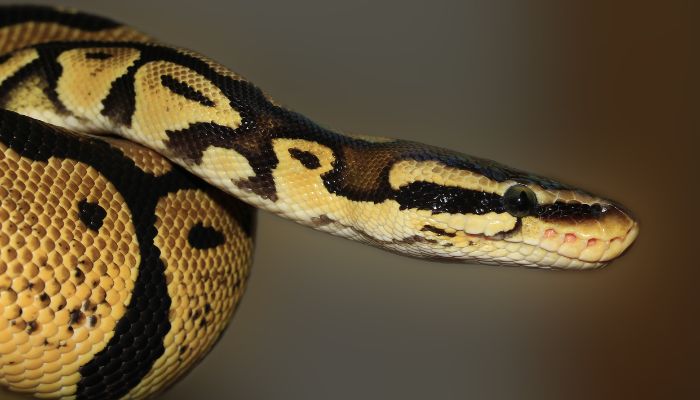
Why Might a Ball Python Not Poop?
Like any pet, they can sometimes behave in ways that leave their owners scratching their heads. One such puzzling behavior is when they don’t poop as expected.
Let’s delve into some reasons why a ball python might hold back on its bathroom duties.
Digestion Issues
Digestion is a complex process, even for a creature as efficient as the ball python. Sometimes, things can go awry. If a ball python consumes prey that’s too large or not properly thawed (for those on a frozen diet), it can struggle to digest it.
This can lead to slower digestion or even partial digestion. In such cases, the snake might delay its defecation or, in rare instances, regurgitate the meal.
It’s essential to ensure that the prey is of appropriate size and, if frozen, thoroughly thawed before feeding.
Impaction
Impaction is a serious concern for ball python owners. It occurs when a hard mass of indigestible material, like substrate or too much fur from prey, gets lodged in the snake’s intestines.
This blockage can prevent the snake from pooping. Symptoms of impaction include a noticeable lump in the snake’s body, lethargy, and refusal to eat. If you suspect impaction, it’s crucial to consult a veterinarian.
They might recommend treatments like warm baths or gentle massages to help pass the obstruction. To prevent impaction, ensure you’re using a safe substrate and feeding appropriately-sized prey.
Hydration
Water plays a pivotal role in the digestive process. A dehydrated ball python can struggle with digestion, leading to harder feces that are difficult to pass.
If the snake’s water dish is often empty or if the humidity in its enclosure is too low, it might not be getting the hydration it needs. Ensure your ball python has constant access to fresh water and monitor the humidity levels.
A hydrated snake is a happy snake, and more likely to stick to its regular pooping schedule.
Temperature
Remember, ball pythons are ectothermic, meaning they rely on external sources to regulate their body temperature. The temperature in their enclosure directly impacts their metabolic rate.
If it’s too cold, their metabolism slows down, leading to slower digestion and delayed defecation. On the other hand, if it’s too warm, they might become overly active, which can also affect their digestive routine.
It’s a delicate balance! Ensure the enclosure has a proper temperature gradient, with a warmer basking area and a cooler resting spot. Regularly check and adjust the temperatures to provide an optimal environment for your slithery friend.
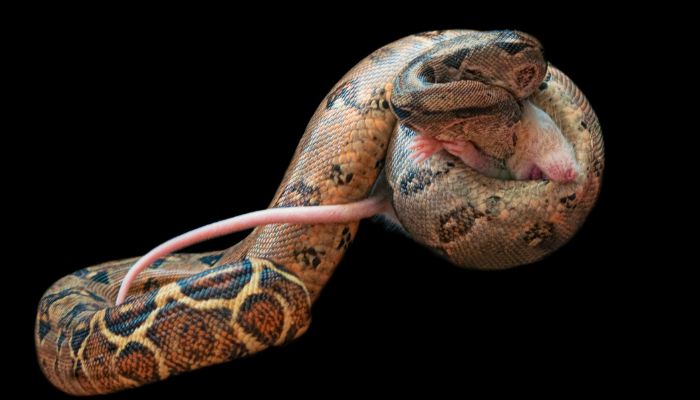
Helping Your Ball Python with Constipation
Constipation in ball pythons can be a concerning issue for owners. It’s essential to know how to help your scaly friend when they’re feeling a bit “backed up.” Here are some tried and true methods to assist them:
Warm Water Trick: Soaking and Drinking
One of the most recommended remedies for a constipated ball python is the warm water trick. Gently placing your snake in a shallow container with lukewarm water can work wonders.
The water should be deep enough to cover the snake’s body but not so deep that it feels threatened. This warm soak can help relax the snake’s muscles and stimulate a bowel movement.
Additionally, the snake might take a few sips of water, aiding in hydration and easing the passage of feces. Remember to always supervise your snake during these soaks to ensure its safety.
When to Consult a Vet: 3 Weeks Without Bowel Movement
While occasional constipation can be normal, especially if the snake has had a larger meal, prolonged periods without defecation can be a cause for concern.
If your ball python hasn’t pooped in three weeks, it’s time to consult a reptile veterinarian. They can provide expert advice, recommend treatments, or even perform procedures to alleviate the issue.
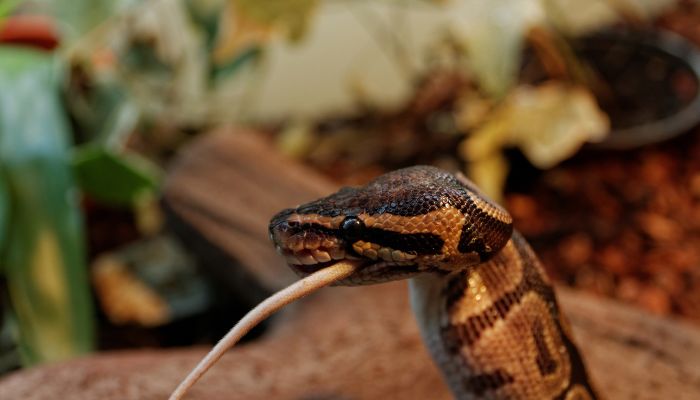
Ball Python Defecation and Health
A ball python’s poop can tell you a lot about its health. Just as we might glance at our stool to gauge our well-being, examining your snake’s feces can provide valuable insights.
Consistency and Color of Healthy Snake Poop
Healthy ball python feces should be firm but not too hard, with a dark brown or black color. It might be accompanied by a chalky white substance, which is uric acid (a byproduct of protein digestion).
If the poop is too watery or too dry, it could indicate potential health issues, such as infections or dehydration.
Presence of Hair in Feces and Its Significance
Don’t be alarmed if you spot hair or fur in your ball python’s poop. Remember, snakes consume their prey whole, and while they digest most of it, some parts like fur or feathers remain indigestible.
The presence of hair in the feces is entirely normal and is a testament to the snake’s efficient digestive system.
However, an excessive amount of hair could indicate that the prey was too furry or large, which might lead to impaction. It’s essential to ensure you’re feeding your snake appropriately-sized prey to prevent such issues.
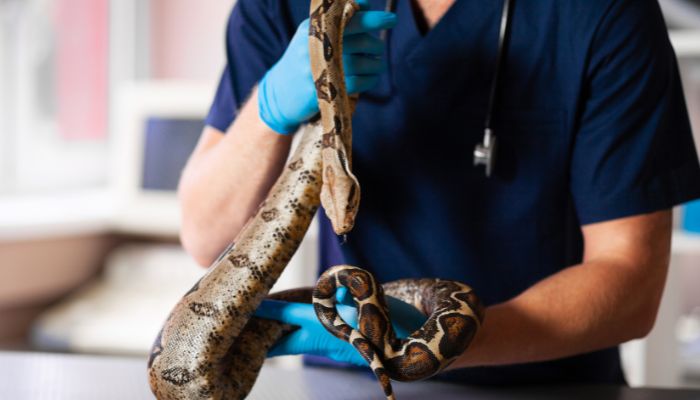
When to See a Vet
Ball pythons, with their captivating patterns and gentle nature, make for fascinating pets. But, like all animals, they can occasionally face health challenges. One of the primary indicators of their well-being is their defecation pattern.
So, when should you be concerned, and when is it time to see a vet? Let’s explore.
Typical Poop Frequency and When to Be Concerned
On average, a ball python will poop about a week after eating. However, this can vary based on factors like diet, environment, and individual habits.
While it’s not uncommon for a ball python to skip a week or even two, going three weeks or more without a bowel movement, especially if they’ve been eating, can be a cause for concern.
It’s essential to monitor their defecation patterns and be alert to any significant changes.
Importance of Knowing Your Snake’s Normal Habits
Every ball python is unique. Some might poop like clockwork every week, while others might have a more leisurely schedule. As an owner, understanding your snake’s regular habits is crucial.
This knowledge will allow you to quickly spot any deviations, helping you address potential issues before they escalate.
Signs of Bacterial or Parasitic Infections
While constipation can be a concern, other symptoms might indicate bacterial or parasitic infections. If your ball python’s feces are unusually watery, have a foul odor, or are tinged with green or yellow, it could be a sign of an infection.
Additionally, if your snake becomes lethargic, loses weight rapidly, or refuses to eat, these could be indicators of underlying health issues. In such cases, it’s imperative to consult a reptile veterinarian promptly.
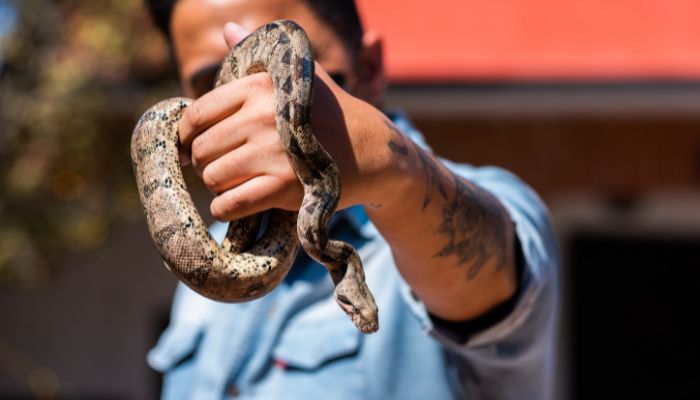
Conclusion
In your journey to understand the intricacies of ball python care, you’ve delved deep into one of the most intriguing aspects: their digestion.
You’ve discovered the various factors that influence “how often do ball pythons poop?” and learned the significance of monitoring their defecation patterns.
From the efficiency of their digestive tract to the potential concerns that might arise, you now have a comprehensive understanding of what’s normal and when to seek expert advice.
Remember, every ball python is unique, and understanding your snake’s individual habits is crucial. By being attentive and proactive, you can ensure your slithery companion thrives in its environment.
Your dedication to learning and providing the best care speaks volumes about your commitment as a pet owner. Keep up the fantastic work, and always trust in the knowledge you’ve gained.
Your ball python is lucky to have such an informed and caring guardian. Keep observing, keep learning, and here’s to many happy, healthy years with your captivating pet!
FAQ
As with any pet, they come with their own set of quirks and questions. Let’s tackle some of the most frequently asked questions about these slithery companions.
How often does a ball python pee?
Ball pythons don’t pee like mammals. Instead, they excrete uric acid, a chalky white substance, alongside their feces. This uric acid is a byproduct of protein digestion. Typically, you’ll notice this white substance every time your python poops, which is roughly once a week after feeding.
How do I know if my ball python is constipated?
If your ball python hasn’t pooped for more than three weeks, especially if it’s been eating, it might be constipated. Other signs include a noticeable lump in its body, lethargy, or refusal to eat. A warm water soak can sometimes help, but if you’re concerned, it’s best to consult a vet.
Do snakes poop after every meal?
Not necessarily. While ball pythons usually defecate about a week after eating, this can vary based on factors like the size of the meal, the snake’s age, and environmental conditions.
What if my snake hasn’t pooped in a week?
Don’t panic! It’s not uncommon for ball pythons to skip a week or even two. However, if it’s been three weeks or more, especially if your snake has been eating, it might be time to investigate further or consult a veterinarian.




0 Comments